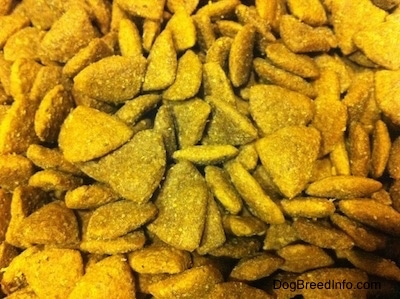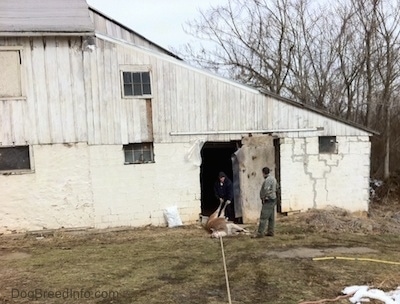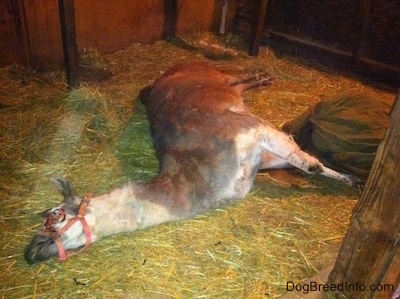
The farmer up the street had a llama die of unknown causes. It took him a day or so to get a tractor down to the barn so he could drag the body out of the stall and get it into his truck. He said he was taking the body to the rendering plant.

A rendering plant is a processing operation where dead animals are recycled into products such as human food, pet food and industrial materials.
They accept and collect animals condemned at slaughterhouses (diseased or dying livestock or poultry with ID tags still attached), slaughterhouse waste, road kill, euthanized cats and dogs from animal shelters and veterinarian offices (including their flea collars containing toxic pesticides, ID tags and a variety of powerful drugs), horses, dead animals from farmers, dead zoo animals, rats, mice, spoiled and unsold grocery store meat still in their plastic and Styrofoam wrappings, butcher shop trimmings that the butcher did not see as fit to sell and even used restaurant grease. The dead, destroyed, dying, disabled, diseased animals are classified in the trade as 4-D meat.

There are many uses for rendered products, but one of the widespread uses in the United States is to make low cost meats for dog and cat foods. This means your dog or cat could be eating other dogs and cats among other inferior 4-D animals not fit for human consumption.
How can you tell if your dog or cat food contains rendered products? Read the ingredients. If the food uses words such as "meat," "animal" or "poultry" without specifying what type of meat or animal it is referring to, there is a good chance that it came from a rendering plant. Some of the ingredient lingo to watch for is...
Below is what those ingredients mean.
Meat and Bone Meal—a dry rendered product from mammal tissues made from slaughterhouse waste and other dead animals not suitable for human consumption. It often contains 50% protein, 35% ash, 8-12% fat, and 4-7% moisture. It includes bone, but does not include blood, hair, hoof, horn, hide trimmings, manure, stomach and rumen contents, except in such amounts as may occur unavoidably in good processing practices. The type of animal is not specified and therefore it can come from any of the sources taken in and processed by the rendering plant including the dead, destroyed, dying, disabled, diseased animals classified as 4-D meat.
Meat Meal—a rendered product from mammal tissues unfit for human consumption. It does not include blood, hair, hoof, horn, hide trimmings, manure, stomach and rumen contents except in such amounts as may occur unavoidably in good processing practices. The type of animal is not specified and therefore it can come from any of the sources taken in and processed by the rendering plant including the dead, destroyed, dying, disabled, diseased animals classified as 4-D meat.
Bone Meal—a rendered product unfit for human consumption (steamed) dried & ground product sterilized by cooking un-decomposed bones with steam under pressure. Grease, gelatin and meat fiber may or may not be removed. The type of animal is not specified and therefore it can come from any of the sources taken in and processed by the rendering plant including the dead, destroyed, dying, disabled and diseased.
Animal Fat—the greasy debris left over after rendering, deemed inedible for humans. It is obtained from the tissues of mammals and/or poultry in the commercial processes of rendering or extracting. It consists predominantly of glyceride esters of fatty acids and contains no additions of free fatty acids. If an antioxidant is used, the common name or names must be indicated, followed by the words "used as a preservative." Where the fat comes from is not specified so it could be any of a combination of the sources taken in and processed by the rendering plant including the dead, destroyed, dying, disabled, diseased animals.
Tallow—animal fats with a titer above 40 degrees Celsius. Tallow is classified by regulators as inedible to humans. Where the fat comes from is not specified so it could be any of or a combination of the sources taken in and processed by the rendering plant including the dead, destroyed, dying, disabled and diseased.
Animal digest—a rendered product material of cooked-down broth made from unspecified body parts from unspecified animals unfit for human consumption. It is the results from chemical and/or enzymatic hydrolysis of clean and un-decomposed animal tissue. Materials treated with heat, enzymes and/or acids to form concentrated natural flavors. It is usually sprayed onto the kibble to make it smell and taste more appealing to the pets eating it. It is an extremely poor source of protein. Since the type of animal is not specified it can be anything accepted and processed by the rendering plant including the dead, destroyed, dying, disabled, diseased animals.
Digest—a rendered product material of cooked-down broth made from unspecified body parts from unspecified animals unfit for human consumption. It is the results from chemical and/or enzymatic hydrolysis of clean and un-decomposed animal tissue. Materials treated with heat, enzymes and/or acids to form concentrated natural flavors. It is usually sprayed onto the kibble to make it smell and taste more appealing to the pets eating it. It is an extremely poor source of protein. Since the type of animal is not specified it can be anything accepted and processed by the rendering plant including the dead, destroyed, dying, disabled, diseased animals.
Digest is a flavoring, not a meat. For example only a small amount of a "chicken digest" is needed to produce a "chicken flavored cat food," even though no actual chicken is added to the food. Digest is unfit for human consumption.
Poultry by-product meal—a dry rendered product of slaughtered poultry consisting of things deemed not fit for human consumption (no muscle meat included), which can include heads, beaks, necks, intestines, undeveloped eggs, viscera, free from fecal content and foreign matter (except in such amounts as might occur unavoidably in good processing practices), but does not include feathers (except in such amounts as might occur unavoidably in good processing practices). Including the dead, destroyed, dying, disabled, diseased birds.
Written by Sharon Rose© Dog Breed Info Center® All Rights Reserved